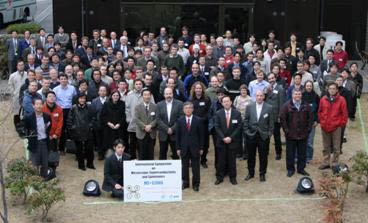From February 27 to March 2, NTT Basic Research Laboratories (NTT BRL)
and CREST-JST held an international symposium on physics entitled "Mesoscopic
Superconductivity and Spintronics" (MS+S2006) at NTT Atsugi R&D
Center. These fields have recently been attracting considerable attention
from scientific researchers and engineers because they are fundamental
areas that may lead to the physical realization of quantum information
processing and computation. Many distinguished researchers in these fields
from all over the world have joined every event of this series of symposium
and given important presentations. It is now recognized as an important
international symposium on mesoscopic. MS+S2006 included 46 oral presentations
and approximately 80 poster presentations.
At the symposium this year, we were impressed by the fact that mesoscopic
superconductivity is attracting attention in terms of applications in addition
to the academic interest. Professor J. Martinis, Professor F. W. J. Hekking,
Professor D. Esteve, Professor J. Clark, Professor C. J. P. M. Harmans,
Dr. K. Semba, Dr. Y. Nakamura, Dr. Wallraff, and Professor A. Ustinov gave
talks on new results in their superconducting qubits(SQubits) experiments.
These people represent almost all the research groups throughout the world
that actually have SQubits in operation. In particular, Professor J. Martinis's
group in UCSB has had a greatest success. They observed two-quantum-bit
entanglement and provided the quantum tomography charts of their system.
On the other hand, the Yale Univ. group showed the entanglement between
their SQubit and a transmission line resonator, and the NTT BRL group demonstrated
entanglement manipulation of their SQubit and a sub-millimeter LC resonance
circuit coupled system, which is known as "vacuum Rabi oscillation".
These two studies are the first clear demonstrations of entanglement in
macroscopic quantum objects.
We also found that rapid progress is being made in spintronics. In particular,
electrical ways of manipulating spins in semiconductor systems generated
great interest in this symposium. A talk on the generation and detection
of spin entanglement in double quantum dots was presented by Professor
C. Marcus of Harvard University. Dr. S. Sasaki of NTT BRL described a gate-controlled
RKKY interaction in a double quantum dot-quantum wire coupled system. Much
attention has focused on the spin-orbit interaction in semiconductors.
Professor D. Awschalom of UCSB demonstrated optical detection of the spin
Hall effect in GaAs and InGaAs. Gate control of spin precession in InGaAs
2DEGs (two-dimensional electron gases) was reported by Professor J. Nitta
of Tohoku University. Professor H. Ohno of Tohoku Univ. observed current-induced
domain wall motion in GaMnAs.
Midway through the symposium, a special lecture on entanglement manipulations
with trapped ions was given by Dr. H. Haffner of Innsbruck. Most participants
were surprised by the admirable skill shown in manipulating ions although
they were not very familiar with the system.
The symposium welcomed approximately 200 participants, of whom a quarter were from overseas. They have now returned home with the dream of fruitful interaction between fundamental physics and information sciences, which will become common in the near future.
